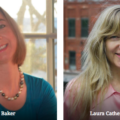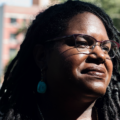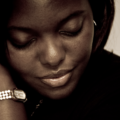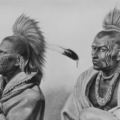Now You See Me, Now You Don’t: Decentering Whiteness in Seattle

There was a talk going on about Black Lives Matters at the Seattle Center. For better or for worse, I suppose lately there is always a talk going on about Black Lives Matters. This one was after Michael Brown but before Sandra Bland. The killing of black bodies seems to be a way to keep track of the calendar these days. I rushed to the entrance of the theatre building, half looking where I was going and half following the blue GPS dot on my phone. I thought I was going to be late and I hate sitting in the back of a room. Slightly out of breath, trying to keep my composure, a black woman with natural hair greeted me at the door with that warm smile that black people share to remind you that you are somebody worthy to be seen. I smiled back. Keeping her bonding gaze, she handed me a program and said, “There’s reserved seating for POC in the front row when you go in. You can sit there.”
It took a while to register what she meant by POC. Not because I didn’t know what it was but because I haven’t thought of myself as a person of color all that much since undergrad. Since then I had worked for a few different charter schools in the New York area—my students were mostly black, my colleagues were mostly black, and most importantly, all my direct supervisors were mostly black. As a bonus, I was living in Harlem, well, back when it was mostly black. For those few years, my identity as a woman of color, a black woman specifically, played in the background of my day-to-day like elevator music. My recent transplantation into Seattle snatched me from that reprieve. The color of my skin, the hole between my legs and the conversation between the two dominated how people saw me and how I began to see myself.
Though disarming at first, disturbing even, this readjustment of my identity was not a bad thing.
I knew literally zero people when I moved to Seattle nearly three years ago. Zero. Cero. To make matters worse, my new career in international development sunk my social life into a deep abyss— leaving for a month, coming back for a month only to leave for another month again made it hard to secure new friendships. And so I defaulted to “yes” for every panel discussion, concert, food festival and the million other local social activities that popped onto my Facebook newsfeed, filled with comments and photos posted by folks I hoped could help reset my buffering quest for community.
Seattle is notorious for the “Seattle Freeze”—the passive aggressive way people from here keep their social circles insulated, making it hard for newcomers to get in. But once again statements thought to represent the whole only represent a part because I just haven’t seen that apply to us. The overwhelming whiteness of Seattle creates a culture of survival for people of color; the need for community sits on skin like a New York City summer heat. The communities I found here are beautifully intentional about cultivating spaces of freedom. Freedom from the racist microaggressions that every day little by little threaten to strip away any sense of agency and power I’ve been able to conjure. Freedom from smalling up myself to give way for others who’ve done nothing to deserve more space than me. Freedom to make something of and for myself, of and for my community. Intricately configured networks burn throughout Seattle, thawing out a path for people of color to connect, create and build together. Suspending that truism that “all skinfolk ain’t kinfolk,” strangers who knew nothing about me and owed nothing to me extended genuine invitations into their own safe spaces, taking care of me in ways I had forgotten I needed.
Do not get me wrong. Seattle is very white. Very very white. But even in that context, it still just takes a peace sign to count the number of white people in my life here outside of work. My boyfriend is one of them. Public displays of our relationship changes the way everyday white people see me, namely that they see me at all. They look at me in the eyes now. They smile at me in that “I voted for Obama” kind of way. I would say that they speak to me, but that would be a stretch. They speak to him. He gets the compliments on how cute we are. We are adorable. He gets the questions at brunch about what we have planned together for the day. Why is this your business? He gets the random dude to stop his bike ride to explain to us him details about the yacht passing us on the canal. I do not care. Maybe my New York state of mind reads all over my face why people don’t approach me. But it’s probably just because I’m black. It is this type of gaslighting whiteness will do to make you feel crazy. In the passive aggressive progressive culture that defines Seattle, this happens all the time.
Being in an interracial relationship has been disruptive at times to the community of burgeoning affirmation that I’ve created. Partly because such intimate proximity to privilege reminds me that although I can move freely with him, I cannot move like him. I love watching him literally stop and smell the flowers. I hate that I often watch him from the sidewalk because I just cannot bring myself to walk onto someone else’s driveway to smell them with him. It’s these moments that remind me that I am a person of color, a black woman specifically, and sometimes my physical presence can be a threat to some people however more palatable I may be because of him. These are the moments that my community protects me from—not in the sense that we keep ourselves isolated to prevent them from happening, but in the sense that they remind me that there is nothing wrong with me. I am not the only one standing in the crooked room.
Identifying as a person of color requires a breadth and depth to see myself in others who despite their differences remain linked to me by the fate of marginalization. I’ve learned so much from my community. Their perspectives, intellect and action often times make me feel just woke by proxy, which nags at me and pushes me to learn more and do more. Explore myself as an artist, challenge how I show up for the community and most critically, relies on me to pay the love forward so others can find the pathways to connect. From that foundation, I can thrive in the fullness of the Pacific Northwest, snowboarding down fresh mountain powder, rowing in a scull across the lake and digging for razor clams on the coast. From that foundation, I can harness the confidence to engineer my life exactly how I want, as I amalgamate and separate the endless versions of myself as needed. From that foundation, I can discover my selfhood in Seattle (of all places) and trust that my community will handle her with care.
About Jodi-Ann Burey
Jodi-Ann Burey lives in Seattle, WA and currently works as a global health professional in sub-Saharan Africa. She is also the founder of For Colored Girls Who Travel (forcoloredgirlswhotravel.com), an online platform of photography, essays and commentary about travel, race and identity for women of color travelers and travel enthusiasts. Learn more about Jodi-Ann at jodiannburey.com.





